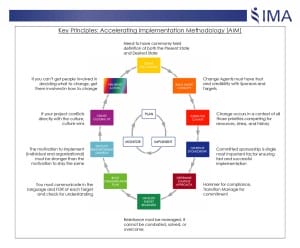
First, define the cultural dimensions of each group impacted by your change. For the SDLC, this is your entire IT organization, senior management and your business users and customers. The SDLC represents a broad sweeping change. It is important to first focus on the “low hanging fruit.” Exploit the aspects of the change that produce the highest yield and lowest risk. Take advantage of any opportunity to lead with results rather than rhetoric. Altogether avoid or reduce the initiatives that are more about image and not reality.
Each of your target groups need to have sponsors who are capable of identifying the cultural characteristics that support the change as well as the values, behaviors and “unwritten rules” that resist the change. Positively reinforce and emphasize the behaviors that support the change. Provide high visibility rewards and recognition for attaining the desired state.
Regardless of how effective your positive reinforcement is, you will face cultural resistance. Someone once asked me, “Why is it necessary to have a company-wide SDLC? We all do things now that are effective for us, why change?” This individual was a member of one of the working teams building and vetting the SDLC processes. His question caught me off guard. He didn’t understand the big picture even though he was serving as a change agent and involved with the very construction of the SDLC. As I thought things through, I realized this question is a direct result of my failure to effectively communicate the vision to the change agents.
For each major source of cultural resistance, you need to discover the answers to these three questions:
- What are the values, behaviors and “unwritten rules” that are motivating the resistance?
- What is it about the culture that reinforces the “unwritten rules?”
- What is it about our system that rewards the “bad” behaviors?
Armed with this intelligence, you can then work to define and implement specific changes that reduce or eliminate the cultural dimensions that reinforce change adversity and execute those that reward the new behaviors. Develop a positive reinforcement plan that is stronger than the motivation to keep the status quo. It requires significantly more sponsorship attention, discipline and stamina to inspire a group to move from “discomfort and resistance” to “opportunity and need.” The sponsors must “walk the talk” and visibly display the new behaviors even if they are individually painful.
Consider offering financial rewards as part of your positive reinforcement plan such as a salary increase, bonus, prize or perk for demonstrating the new behaviors. Apply the positive rewards immediately after observing the performance of the new behaviors. Celebrate early successes and wins. Do whatever you can to make it more difficult to continue to operate in the old state.
Build an effective communication plan that explains the objectives and rationale, the time frame and the cost of not changing. Implement the communication plan early and communicate often. Send out frequent progress updates. Focus the organization’s attention forward and generate an excitement about the new changes to the SDLC. Commission surveys or walk around the floor to learn if people understand the message. Are they getting it? Keep your communications credible, comprehensive and clear.
We’ve only touched upon a few aspects of organizational change management. There are a lot of moving parts to any organizational change, but especially so when rolling out a SDLC. An organizational change management strategy is much broader than the few examples I’ve presented here, but for a SDLC implementation, it is absolutely essential.


Leave a Reply